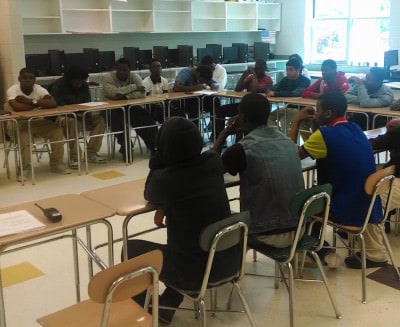
Editor’s Note: Last week, a report was issued by the Southern Educational Foundation, showing that low income students are now a majority of the students attending the nation’s public schools. 51% of the students across the nation’s public schools were low income in 2013. In North Carolina, 53% of the students were low income in the same year. An article in The Washington Post says, this is “a statistic that has profound implications for the nation.” With this report in mind, I asked Ellie Herman for permission to run this segment of a blog she posted last year. Note that her context is California, and North Carolina is already addressing these issues in a number of ways, including among others the new teacher support program, regional leadership academies, district and school transformation work, and many local initiatives.
Click here for an in-depth perspective on education and poverty by Dr. Helen F. “Sunny” Ladd, the Susan B. King professor of public policy and professor of economics at Duke University’s Sanford School of Public Policy.
Teachers in high-poverty communities need professional working conditions. If they do not have professional working conditions, we will never be able to narrow the achievement gap between children of color in generational poverty and their more affluent white peers, who often are showered with opportunity and enrichment from the time they are born.
Teachers in high-poverty communities are expected to be “effective” at working with five to six classrooms a day of 35 to 50 students, many of whom are reading far below grade level, many of whom have serious behavior issues that make it difficult for them to sit at a desk quietly, all of whom have grown up in school systems with an ever-rotating cast of teachers who sometimes walk off the job in despair in the middle of the year or just check out and burn out and stop caring. We do not acknowledge that many of these students quite understandably do not trust the school system in the first place, and so that trust first needs to be rebuilt, often painfully and slowly.
We do not give teachers in high-poverty communities the training they need to work in those communities.
Teaching in high-poverty communities is different than teaching in more affluent communities. It should be regarded as a specialty because of its complexity and depth. Right now, the opposite occurs. We do not give teachers in high-poverty communities the training they need to work in those communities. We do not teach them how to manage overcrowded classrooms with students when some of them, for a variety of reasons, have difficulty sitting at a desk or restraining themselves from talking. We do not train teachers how to find time to grade 150 papers from 11th grade students who are writing at a 6th grade level in a way that will help them learn and improve.
When they are on the job, we do not give them mentoring, support or ongoing training. We do not give them anywhere near enough time to meet the needs of their students. We deny the emotional needs of those students, pretending that being raised in deep poverty is not traumatic, pretending that there is no institutional racism that needs to be acknowledged and addressed. We deny the utter lack of resources in high poverty communities: the lack of access to medical care, counseling, jobs, food.
What do I mean by professional working conditions? Here’s what I mean:
- Teachers in high-poverty communities need the training to do the job well. This means training that acknowledges the unique challenges and rewards of working in a high-poverty community, not just in the superficial “teach like a champion” style that produces compliance but in a deep way that sees the human needs of children in the classroom and of the community outside that room. It means an intern year in the classroom of an expert mentor teacher because teaching is a three-dimensional, human job that cannot be understood without doing the work. We need specialized education programs that recruit committed students specifically to do this work, not for two years as TFA does, but as a career that deserves time and attention.
- Teachers in high-poverty communities need the time to meet the needs of students. It’s just simply unacceptable to pack 35 to 50 students into a classroom in a high-poverty community and then expect those teachers to teach five to six classes per day, sometimes with after-school activities tacked on as well. You’re talking about students who may be reading far below grade level, who may be living in traumatic conditions, who may need therapy, who for a host of excellent reasons may not trust the school system or adults, who have never had access to books and whose parents did not have the opportunity to have education through high school. Teachers in high-poverty communities should have a much smaller caseload because the academic and emotional needs of their students are more complex. They need time to know their students and to build trust.
What if, instead of just demanding excellence, we really took the time to create conditions in which excellence was possible?
- Teachers in high-poverty communities need time to grade and read work carefully. Grading is the monster in the room, right? And yet we don’t even make time for it in a teacher’s day; it’s an afterthought. Grading is always a beast, but in a high-poverty community, it needs to be done with painstaking care and detail because students are so far behind that commentary needs to be meaningful and helpful. Teachers need time to think through students’ logical lapses and explain them in a way that makes sense. Grading is a job unto itself in high-poverty communities and needs to be treated as an art. It is the way a teacher has an individual conversation with a student; we need to acknowledge that these conversations matter intensely. A teacher with 150 to 200 students simply does not have time to do this work—or if they do the work well on top of an 8-10 hour day on their feet managing a high-needs classroom, they will burn out.
- Teachers in high-poverty communities need resources to enable access to 21st century literacy. We need to acknowledge that students in high-poverty communities do not have equal access to books, computers, internet bandwidth or space and time to do work—and their teachers also do not have equal access. This does not mean throwing a billion dollars at Apple as John Deasy1 did; surely corporations can be asked not to profit from the poverty around them. It absolutely does not mean shelling out billions for products designed to help students score well on the new Common Core tests, from which Pearson and other testing companies are profiting unconscionably. It means taking a look at the resource needs, all the resource needs, not just their need for a particular gadget, of students in high-poverty communities before we start testing them (if we do at all). If we don’t meet those resource needs first, all we’re testing is their lack of access. We need to stop holding teachers in high-poverty communities responsible for that lack and start providing them with the resources they need to do the job.
- Teachers in high-poverty communities need a sustainable career path. First of all, we need to acknowledge that in the 21st century, very few people stay at one job for life. We live in an entrepreneurial age. Let’s stop expecting teachers to stay in the classroom forever—and for those who crave a new challenge after some years, create conditions where they can stay in the community and continue to make a wider or deeper contribution in education, whether as a principal (which means we need to re-think principal working conditions) or as a master teacher mentoring others and creating curriculum for the unique needs of the community. Let’s stop pretending to “motivate” anyone with merit pay based on test scores or rubric evaluations. No human being is motivated that way. We are not lab rats motivated by pellets. Here’s what motivates teachers: the conditions in which they can do meaningful work, address the needs of their students and continue to learn to be better. If we care about the needs of students in high-poverty communities, we need to work to retain excellent teachers there—not to drive them from the classroom after two years, burned out and heartbroken.
That’s it. That’s my call to action. Will it be expensive? Probably – but no more expensive than spending billions on standardized testing. What if we took that money and invested it in our highest-needs communities instead? What if, instead of just demanding excellence, we really took the time to create conditions in which excellence was possible?




